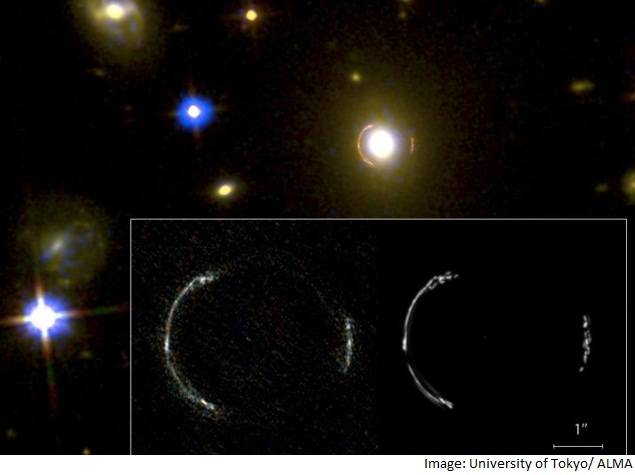- Home
- Science
- Science News
- Inner Structure of Galaxy at Edge of Universe Depicted in Unprecedented Detail
Inner Structure of Galaxy at Edge of Universe Depicted in Unprecedented Detail

The monstrous galaxy called Session Description Protocol (SDP).81 is located 11.7 billion light-years away from the Earth in the constellation called Hydra. The researchers used the Atacama Large Millimeter/submillimeter Array (ALMA) located in the Atacama desert, northern Chile, with the assistance of a "natural telescope" known as a gravitational lens.
The team modelled the lensing effects and corrected them to reveal the distribution of huge stellar cradles in the monstrous galaxy.
The same model, developed by Yoichi Tamura and Masamune Oguri, assistant professors at the University of Tokyo, also indicates the existence of a supermassive black hole at the centre of the foreground galaxy.
Using their model, they corrected for lensing effects and revealed that SDP.81 is a monstrous galaxy forming stars at hundreds to thousands of times the rate, we see in the Milky Way.
This is the first time astronomers have been able to reveal the inner structure of such a distant galaxy. The model shows that the fine structures in the ring reflect the inner structure of SDP.81.
Researchers found that several dust clouds with sizes of 200 - 500 light-years are distributed within an elliptic region 5,000 light-years across.
The dust clouds are thought to be giant molecular clouds, the birthplaces of stars and planets. The clouds in SDP.81 have sizes similar to those found in our Milky Way and nearby galaxies
"This discovery is an important step to understand the evolutionary process of starburst galaxies and supermassive black holes in galaxies," the authors said.
The paper appeared in the journal Publications of the Astronomical Society of Japan.
Get your daily dose of tech news, reviews, and insights, in under 80 characters on Gadgets 360 Turbo. Connect with fellow tech lovers on our Forum. Follow us on X, Facebook, WhatsApp, Threads and Google News for instant updates. Catch all the action on our YouTube channel.
Related Stories
- Samsung Galaxy Unpacked 2025
- ChatGPT
- Redmi Note 14 Pro+
- iPhone 16
- Apple Vision Pro
- Oneplus 12
- OnePlus Nord CE 3 Lite 5G
- iPhone 13
- Xiaomi 14 Pro
- Oppo Find N3
- Tecno Spark Go (2023)
- Realme V30
- Best Phones Under 25000
- Samsung Galaxy S24 Series
- Cryptocurrency
- iQoo 12
- Samsung Galaxy S24 Ultra
- Giottus
- Samsung Galaxy Z Flip 5
- Apple 'Scary Fast'
- Housefull 5
- GoPro Hero 12 Black Review
- Invincible Season 2
- JioGlass
- HD Ready TV
- Laptop Under 50000
- Smartwatch Under 10000
- Latest Mobile Phones
- Compare Phones
- Realme P4x 5G
- OnePlus Ace 6T
- Nubia Flip 3
- Nubia Fold
- OPPO A6x 5G
- Samsung Galaxy Z TriFold
- Poco F8 Ultra
- Poco F8 Pro
- Asus ProArt P16
- MacBook Pro 14-inch (M5, 2025)
- Poco Pad M1
- Poco Pad X1
- Just Corseca Skywatch Pro
- Honor Watch X5
- Acerpure Nitro Z Series 100-inch QLED TV
- Samsung 43 Inch LED Ultra HD (4K) Smart TV (UA43UE81AFULXL)
- Asus ROG Ally
- Nintendo Switch Lite
- Haier 1.6 Ton 5 Star Inverter Split AC (HSU19G-MZAID5BN-INV)
- Haier 1.6 Ton 5 Star Inverter Split AC (HSU19G-MZAIM5BN-INV)
















